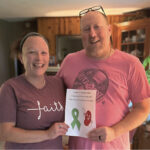It finally seems winter is over! The weather has started to warm up and the first spring flowers are blooming. It’s also the time when lots of kids come into the office with stuffy noses, coughing and sneezing and parents ask me about seasonal allergies.
Seasonal allergies (also known as hay fever) are believed to affect up to 40 percent of children. Children affected by seasonal allergies will react during certain times of the year, usually when outdoor molds release spores, or trees, grasses and weeds release pollen. A child may be allergic to one or more types of pollen or mold. An individual’s specific allergies will determine when symptoms occur. For example, in central Pennsylvania, tree pollen is present from late February through May. Grass pollen is present late April through early July. Molds are present once the snow melts to when it returns, but peak mid-June to mid-August.
Allergies are uncommon in children under 2 years of age. It seems at least a couple of years of allergen exposure are needed before symptoms develop. Allergies usually present in a child by 10 years old and peak in the early 20s with symptoms typically disappearing later in adulthood.
Allergy symptoms may be very similar to symptoms of the common cold and include sneezing, coughing, stuffy nose, runny nose, itchy nose, itchy throat and fatigue. In addition, children may have itchy, watery or red eyes.
Unlike the common cold, allergy symptoms will often show up at the same time every year. Children with colds may run fevers, which are not seen with allergies. Lastly, most colds will resolve in about 7-10 days with allergies persisting beyond this time frame.
As a physician and parent, distinguishing between a cold and allergies can be helpful as the common cold is usually managed with supportive care. For colds, this includes taking a bath at bedtime, running a cool-mist humidifier in the bedroom, and encouraging lots of fluids. There is currently no evidence to support the use of over the counter cough/cold medications in management of the common cold. In fact, some of these products may actually cause serious side effects. In contrast, there are treatments available for seasonal allergies.
The first step in allergy management is to avoid exposure if the allergen is known. Blood and skin testing is available to test an individual for reactions to specific allergens and your child’s doctor can decide if such testing would be beneficial. You may hear about the pollen count during the weather report in the springtime. The pollen count is a measure of how much pollen is present in the air. Typically, pollen counts are highest in the morning and on warm, dry, breezy days. Pollen counts decline in the afternoon and early evening and in wet, chilly weather. If your child has seasonal allergies, it may be helpful during their peak allergy season to keep windows closed, use the air conditioning and stay inside if the pollen counts are high. Having children bathe and change after playing outside can also reduce allergy symptoms.
If avoidance alone does not help symptoms, several medications are available. These typically include oral antihistamines (e.g. Claritin, Zyrtec, Allegra). A physician may also prescribe a steroid nasal spray (e.g. Flonase, Nasonex). If symptoms cannot be managed with medications, allergy shots (immunotherapy) may be recommended in consultation with an allergist. The goal of allergy shots is to gradually desensitize children to particular allergens.
Bad seasonal allergies can significantly impair a child’s ability to participate in school, sports and other outdoor activities. I find allergies are sometimes very frustrating for both parents and children. Once it is determined a child has seasonal allergies, it is important for parents and physicians to work together to optimize treatment so children can function at their best.





